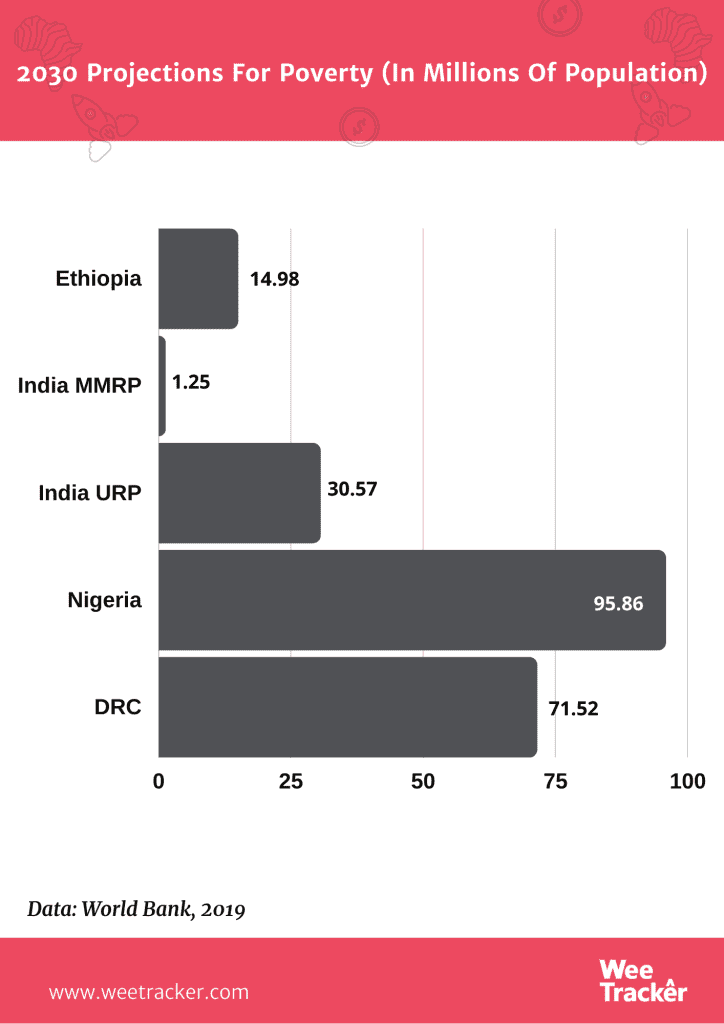Nigeria, DRC & India Have One-Third Of The World’s Poverty Headcount

A reverse from the coronavirus-controlled economic crisis could very well happen in 2021. Nevertheless, the number of people who have been pushed into extreme poverty as a result of the outbreak will remain unchanged.
The Covid-19 cataclysm is not yet over, and three-quarters of new cases realized each day are now in developing countries. The spread of the virus has government juggling health and economic consequences, a series of ripple effects that affects the standard of living.
Nigeria, Congo & India
It is not unheard of that Nigeria, the Democratic Republic of Congo and India have some of the world’s highest number of poor people. However, the World Bank’s new Covid-19-hinged poverty outlook reveals that these three countries have more than one-third of the world’s most impoverished people.
According to the Bank, India accounts for 24 percent of the world’s poor, while Nigeria and DRC have 12 percent and 7 percent, respectively. These figures sufficed alongside the Bretton Woods institution’s projections that the global pandemic is serious enough to drive between 70 and 100 million people into extreme poverty.
These sets of people are not predicted to grow faster than their respective populations, which means extreme poverty will maintain high levels from 2020 through to next year. Recall that the World Bank has also predicted that the public health emergency could result in a global recession—the world’s worst in about 80 years.
Extreme poverty—living on USD 1.90 per day—was on a decrease before Covid-19. But its growth is expected to rebound by 4 percent in 2021. Meanwhile, Nigeria, DRC and India’s per capita growth rates in real GDP (Gross Domestic Product) are projected at -0.8 percent, 2.1 percent and 0.3 percent respectively.
Figures In Retrospect
In 2019, a publication on the World Bank’s Data Blog revealed that half of the world’s total 736 million extreme poor people lived in just 5 countries—Nigeria, India, DRC, Ethiopia and Bangladesh.
These countries, interestingly, are the most populous in South Asia and Sub-Saharan Africa—2 regions which make up 85 percent of the world’s poorest.
Sub-Saharan Africa is on the edge of a recession-shaped gully and it seems its poor will be on the chopping block if things do go sideways. The number of extremely poor people in the country was already on the rise before the coronavirus crisis.
According to previous non-Covid-19-related forecasts, nearly 9 in every 10 extremely poor persons will live in Sub-Saharan Africa.

“A large share of the new extreme poor will be concentrated in countries that are already struggling with high poverty rates and numbers of poor. Almost half of the projected new poor will be in South Asia, and more than a third in Sub-Saharan Africa. Under the baseline scenario, the number of extreme poor in IDA, Blend and FCV countries is projected to increase by 21, 10 and 18 million, respectively,” the Bank said.
Case Scenarios
Projections for the poverty impact of the Covid-19 are that the number of people living under the international poverty lines for lower and upper middle-income countries—USD 3.20 and USD 5.50 per day, respectively—will increase significantly. This will mark that the social and economic impacts will be widely felt.
Specifically, under the baseline scenario, COVID-19 could generate 176 million additional poor at USD 3.20 and 177 million additional poor at USD 5.50. This is equivalent to an increase in the poverty rate of 2.3 percentage points compared to a no-COVID-19 scenario, according to the WB.
A huge chunk of the people that will join the extreme poor will come from nations already in the poverty quagmire. Nearly half of the new poor will come from South Asia, while over a third will be concentrated in Sub-Saharan Africa. Under the WB’s baseline scenario, the number of extremely poor from IDA, Blend and FCV countries may increase by 21, 10 and 18 million respectively.
Photo: Martin Jernberg Via Unsplash.